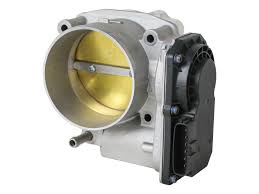
A vehicle’s engine depends on the throttle body to manage the flow of air into the combustion chamber. The engine would experience poor functionality resulting in sluggish performance and higher fuel consumption without the throttle body. Regular maintenance of the throttle body ensures engine efficiency and longevity despite many drivers neglecting to consider this component often.
This guide examines the throttle body’s function and operation while explaining potential failure causes and maintenance tips to preserve its optimal performance.
How the Throttle Body Works
The throttle body sits between the air intake system and the engine’s intake manifold. The throttle body functions as a gateway through which the proper amount of air combines with fuel prior to combustion. The throttle body opens when you press the accelerator which permits more air to enter and results in increased power and speed. The throttle body closes when the pedal is released which decreases airflow to the engine and results in the vehicle slowing down.
In older vehicles the accelerator pedal connected to the throttle body through a cable mechanism which controlled the airflow. Modern cars utilize electronic throttle control (ETC) systems that enable sensors to transmit signals to the engine control unit (ECU) for regulating airflow. This system delivers improved operation smoothness while optimizing fuel economy and emissions management.
The throttle body remains an essential component for engine performance
The throttle body maintains critical engine functions by controlling airflow.
Fuel Efficiency: The correct air-to-fuel ratio enables efficient fuel combustion in the engine while minimizing wastage.
Smooth Acceleration: A properly operating throttle body enables immediate engine response whenever you press the gas pedal.
Stable Idling: The engine keeps a steady idle speed because a clean throttle functions correctly.
Emission Control: When the throttle body malfunctions it creates extra emissions which harm the environment.
What Causes Throttle Body Problems?
Your vehicle’s performance can be affected by different factors which cause throttle body problems. The most common causes include:
1. Carbon Build-Up
Carbon deposits and dirt gradually build up on the throttle body which blocks the throttle plate from operating properly. The throttle body’s failure results in substandard acceleration and unstable idling.
2. Faulty Sensors
Current throttle bodies depend on sensor systems to transmit information to the ECU. When the throttle position sensor (TPS) or mass airflow sensor (MAF) fails it sends wrong data to the ECU which leads to erratic engine performance.
3. Electrical Issues
Electronic throttle control systems face operational issues when wiring problems occur alongside sensor failures and ECU glitches.
4. Mechanical Wear and Tear
The deterioration of linkages and cables in older vehicles with mechanical throttles can create delayed throttle response or cause sticking issues.
5. Vacuum Leaks
Intake manifold leaks along with vacuum hose leaks create airflow imbalances that result in engine instability.
Signs That Your Throttle Body Needs Attention
Multiple noticeable symptoms can result from a malfunctioning throttle body. If you notice any of these symptoms your throttle body might need cleaning or replacement.
Unstable Idle: During idle operation the engine might rev too high or too low while also experiencing fluctuations.
Slow or Hesitant Acceleration: A malfunctioning throttle produces delayed acceleration when you press the gas pedal.
Stalling: The engine has a tendency to stall when the throttle plate operates incorrectly particularly during low-speed operation.
Check Engine Light: The ECU identifies airflow irregularities or sensor malfunctions which cause the dashboard warning light to activate.
Increased Fuel Consumption: When the throttle becomes defective it causes an improper air-fuel mixture that leads to excessive fuel consumption in the engine.
Maintaining your throttle body through regular cleaning helps to avoid expensive repairs and ensures smooth engine operation.
Regular maintenance of the throttle body helps avoid expensive repairs while ensuring your engine operates efficiently. Here’s what you can do:
1. Regular Cleaning
Dirt buildup and carbon residue form the primary causes of throttle body problems. Cleaning the throttle body every 30,000 to 50,000 miles using throttle cleaner helps preserve engine performance.
How to clean a throttle body:
Disconnect the battery to reset the ECU.
Detach the hose that supplies air to the throttle body during maintenance.
Apply throttle cleaner to a cloth before using it to scrub dirt from the throttle plate.
Eliminate persistent deposits with either a brush or soft cloth.
Reinstall components and reconnect the battery.
2. Inspect Sensors and Wiring
Sudden failures of electronic throttle bodies can be prevented by conducting inspections on the throttle position sensor (TPS) and its wiring to detect any damage.
3. Replace Air Filters Regularly
When an air filter becomes clogged, dirt can get into the intake system which results in throttle body contamination. Regular replacement of the air filter according to suggested schedules ensures a clean throttle.
4. Monitor Fuel Quality
Proper detergents in high-quality fuel help prevent carbon deposits from forming within the throttle body and intake manifold.
Should You Replace a Throttle Body?
Throttle body replacement becomes necessary when standard cleaning and maintenance procedures fail to resolve issues. Signs that a replacement is necessary include:
Your vehicle continues to stall or idle roughly despite thorough cleaning procedures.
Unresponsive throttle, leading to poor acceleration
The check engine light frequently illuminates due to throttle performance problems.
The throttle plate or housing shows significant mechanical deterioration.
Experts should install and calibrate the new throttle body when replacing it to make sure it works properly with the ECU.
Final Thoughts
The throttle body serves as a key component of your vehicle’s engine by managing airflow to deliver maximum performance. When the throttle body becomes dirty or develops faults it leads to weaker acceleration while causing both rough engine idling and higher fuel consumption rates. Scheduled maintenance through cleaning the throttle body and checking its sensors along with regular air filter replacements maintains its optimal performance. A professional assessment followed by a replacement might be required to restore your vehicle’s efficiency if problems continue. A properly maintained throttle body enhances your vehicle’s driving performance while also prolonging engine life.